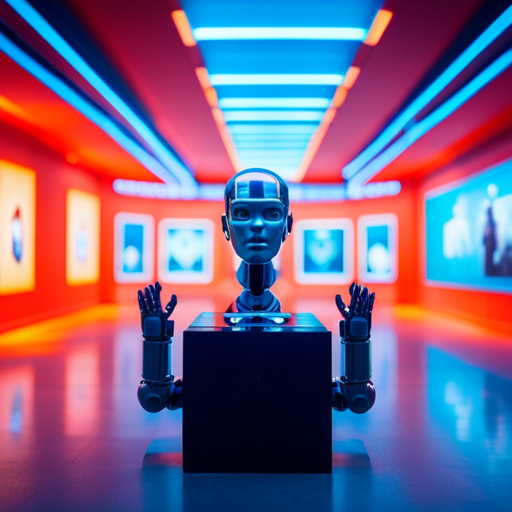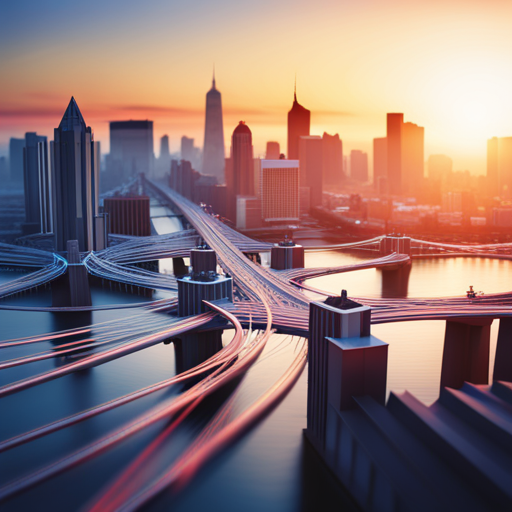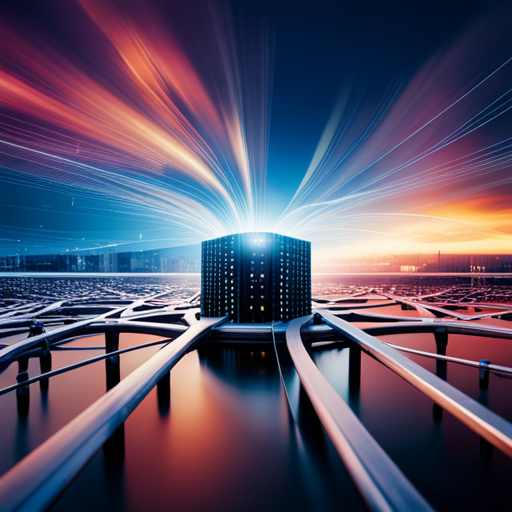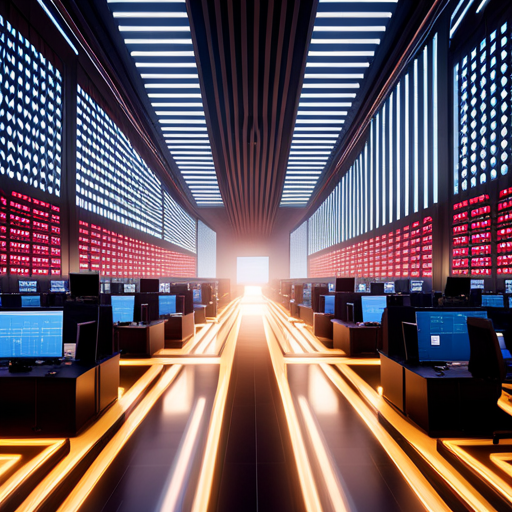Are you curious about the future of visual art?
In this article, we will explore how AI is revolutionizing image generation. You’ll discover the evolution of AI in visual art and its impact on traditional techniques.
We’ll also delve into the exciting world of AI-generated art in the digital age, pushing boundaries and creating new possibilities.
Join us as we examine the ethical considerations surrounding AI-generated visual art.
Get ready to be inspired by the endless creative potential of AI.
Key Takeaways
– AI technology has transformed the field of visual art, allowing for the generation of unique and stunning images.
– AI tools have opened up new possibilities for artistic expression and can assist in generating realistic landscapes, portraits, or abstract compositions.
– AI-generated art allows artists to push the boundaries of creativity and challenge conventional notions of creativity and aesthetics.
– AI-generated images offer endless creative possibilities and can be used in various industries, inspiring new forms of storytelling.
The Evolution of AI in Visual Art
@ Midjourney AI Image Prompt: /imagine prompt:Create an image showcasing the progression of AI in visual art. Start with an ancient cave painting, transition to a classical masterpiece, then transform into a futuristic, AI-generated artwork. –v 5.2 –ar 16:9
The use of AI has greatly transformed the field of visual art. With AI technology, artists like you now have access to powerful tools that can generate unique and stunning images. AI algorithms can analyze vast amounts of data, learn patterns, and create original artwork based on the learned information. This has opened up new possibilities for artistic expression and experimentation.
By utilizing AI, you can push the boundaries of traditional art techniques. AI-powered software can assist you in generating realistic landscapes, portraits, or abstract compositions. You can use these generated images as a starting point for your own creative process. AI can provide you with alternative perspectives and inspire you to think outside the box.
Moreover, AI can help you streamline your creative workflow. It can automate repetitive tasks, such as color correction or image enhancement, allowing you to focus more on the artistic aspect of your work. AI algorithms can also analyze and categorize large image databases, making it easier for you to find inspiration and references for your projects.
AI’s Impact on Traditional Art Techniques
@ Midjourney AI Image Prompt: /imagine prompt:Create an image that depicts a brushstroke made by a robotic arm, blending seamlessly with a brushstroke made by a human hand, symbolizing the harmonious coexistence of AI and traditional art techniques. –v 5.2 –ar 16:9
Using AI to create art has significantly impacted traditional techniques. With the introduction of AI tools, artists like yourself have gained access to new and innovative ways of creating art. AI algorithms can analyze and understand existing art forms, allowing you to experiment with different styles and techniques. You can now use AI-powered software to generate new ideas, explore different compositions, and even create entire artworks automatically. This technology has opened up a whole new world of possibilities for artists, enabling you to push the boundaries of your creativity.
AI can also be used as a powerful tool for learning and improving your traditional art skills. By studying AI-generated art, you can gain insights into different artistic techniques, color palettes, and compositions. This knowledge can then be applied to your own traditional artworks, enriching your artistic repertoire.
However, it is important to remember that AI is not a replacement for traditional art techniques. While AI can assist you in generating ideas and exploring new artistic territories, it is your unique perspective and artistic vision that truly brings your artworks to life. So, embrace the opportunities that AI offers, but always remember to stay true to your own artistic voice.
Pushing Boundaries: AI-Generated Art in the Digital Age
@ Midjourney AI Image Prompt: /imagine prompt:Create an image that showcases a mesmerizing fusion of surreal and hyperreal elements, blending traditional artistic techniques with cutting-edge AI algorithms, illustrating the limitless possibilities of AI-generated art in the digital era. –v 5.2 –ar 16:9
Embrace the endless possibilities of AI-generated art in the digital age. It allows you to push the boundaries of your creativity and redefine traditional artistic norms. With AI, you can explore new realms of artistic expression and create groundbreaking visual masterpieces.
Here’s how AI-generated art can revolutionize your creative process:
– Unleash your imagination: AI opens up a world of infinite possibilities. It enables you to imagine and create art that was once unimaginable. Let the algorithms inspire you to think outside the box and explore uncharted territories in your artistic journey.
– Collaborate with machines: AI can be your creative partner, working hand-in-hand with you to bring your ideas to life. Embrace the collaboration between human and machine, blending your unique artistic vision with the computational power of AI to achieve new levels of artistry.
– Challenge traditional norms: AI-generated art challenges the conventional notions of creativity and aesthetics. Break away from traditional artistic norms and experiment with unconventional techniques and styles. AI can help you break free from the constraints of the past and redefine what it means to be an artist in the digital age.
Exploring the Creative Possibilities of AI-Generated Images
@ Midjourney AI Image Prompt: /imagine prompt:Create an image that showcases the mesmerizing fusion of traditional and AI-generated art forms. Portray an ethereal landscape where brushstrokes and pixels seamlessly blend, inviting viewers to ponder the boundless creative potential of AI-generated images. –v 5.2 –ar 16:9
Get ready to dive into the world of creative possibilities with AI-generated images. With the advancements in artificial intelligence, the realm of visual art has expanded beyond imagination. AI algorithms have the ability to create stunning and unique images that challenge traditional notions of art. From abstract masterpieces to surreal landscapes, the creative potential seems limitless.
Imagine having access to an AI system that can generate an infinite number of images based on your preferences. You can explore different styles, genres, and moods with just a few clicks. AI-generated images open up a whole new world of experimentation and exploration. You can blend different elements, mix colors, and manipulate shapes to create something truly unique and captivating.
AI-generated images also provide a platform for collaboration between humans and machines. You can use AI algorithms to enhance your own artistic abilities or work in tandem with the AI to create something completely new. It’s a fusion of human creativity and machine intelligence, pushing the boundaries of what is possible in the world of visual art.
The possibilities are endless when it comes to AI-generated images. They can be used in various industries, from advertising and design to entertainment and gaming. They can inspire new forms of storytelling and bring imagination to life.
Ethical Considerations in AI-Generated Visual Art
@ Midjourney AI Image Prompt: /imagine prompt:Create an image showcasing contrasting elements: an AI-generated artwork exhibiting vivid colors, intricate patterns, and abstract forms, juxtaposed with a human artist contemplating ethical concerns, evoking curiosity and sparking a dialogue on the future of AI-generated visual art. –v 5.2 –ar 16:9
When considering ethical implications in AI-generated visual art, you need to address issues such as attribution, copyright, and the potential for bias in the algorithms.
AI-generated art raises questions about who should be credited as the artist. While the AI system may have created the image, it was ultimately programmed by human developers. Determining the appropriate attribution becomes crucial in recognizing the contributions of both the AI and its human creators.
Copyright is another important consideration. AI-generated art blurs the lines of ownership and originality. Who owns the rights to an AI-generated artwork? Is it the AI system itself, the developers, or the person who trained the AI? These questions require careful examination to ensure fair and appropriate distribution of rights and royalties.
Additionally, the potential for bias in AI algorithms presents ethical challenges. If the AI system is trained on a biased dataset, it could perpetuate or amplify existing biases in society. For example, if an AI algorithm is trained on a dataset consisting primarily of images of white individuals, it may struggle to accurately represent and generate images of people from diverse racial backgrounds.
Considering these ethical implications is crucial as we navigate the future of AI-generated visual art. By addressing issues of attribution, copyright, and bias, we can work towards a more inclusive and responsible use of AI in the art world.
Frequently Asked Questions
What Are the Technical Advancements That Have Led to the Evolution of AI in Visual Art?
Technical advancements like improved algorithms and increased computing power have led to the evolution of AI in visual art. You can now generate realistic and detailed images using AI, pushing the boundaries of what is possible in artistic expression.
How Has AI Impacted Traditional Art Techniques and the Role of Human Artists?
AI has greatly impacted traditional art techniques and the role of human artists. Through its advancements, AI has introduced new tools and possibilities, challenging artists to adapt and collaborate with technology to create unique and innovative art forms.
What Are Some Examples of Ai-Generated Art That Have Pushed the Boundaries in the Digital Age?
Some examples of AI-generated art that have pushed the boundaries in the digital age include computer-generated paintings, 3D printed sculptures, and interactive installations that blur the line between reality and virtual reality.
How Can AI Be Used to Explore New Creative Possibilities in Image Generation?
AI can help you explore new creative possibilities in image generation by enabling you to push the boundaries of traditional art. It allows you to experiment with different styles, techniques, and concepts, opening up a world of innovation and artistic expression.
What Are Some Ethical Considerations That Arise With the Use of AI in Visual Art, Particularly in Terms of Copyright and Authorship?
Some ethical considerations that arise with the use of AI in visual art, particularly in terms of copyright and authorship, are whether AI-generated art can be copyrighted and who should be recognized as the author.
Conclusion
Overall, exploring the future of visual art with AI for image generation is an exciting and transformative journey. AI has revolutionized traditional art techniques, pushing boundaries and unlocking creative possibilities in the digital age.
However, it is crucial to consider the ethical implications that come with AI-generated art. As technology continues to advance, artists and society must navigate the fine line between human creativity and machine assistance.
With careful consideration and responsible use, AI has the potential to revolutionize the art world, creating new and innovative forms of artistic expression.



